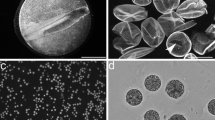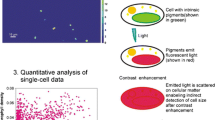Abstract
The percentage of dividing individuals and temporal reproductive patterns were determined for natural populations of several planktonic protists including five species of tintinnids, a dinoflagellate, and a diatom. To obtain these data, a method was used in which the nuclei of planktonic ciliates and phytoplankters can be fluorescently stained with acridine orange at the time of collection and fixation. The technique is simple and can be used routinely in studies of reproduction or other life cycle phenomena of natural protistan populations. For the tintinnids, often more than half of the individuals were in some recognizable stage of fission; periodicity in the division process was only observed once and apparently followed a pulse of conjugation in the population. With the diatom Ditylum brightwellii the fluorescent staining technique yielded data on the extent and timing of division which were consistent with, but more complete than, previous enumerations of paired cells.
Similar content being viewed by others
Literature Cited
Ammermann, D.: Morphology and development of the macronucleus of the ciliates Stylonychia mytilus and Euplotes aediculatus. Chromosoma 33, 209–238 (1971)
Ammermann, D., G. Steinbrück, L. von Berger and W. Henning: The development of the macronucleus in the ciliated protozoa Stylonychia mytilus. Chromosoma 45, 401–429 (1974)
Apstein, C.: Ein Fall von Conjugation bei Tintinnen. Schr. naturwiss. Ver. Schleswig-Holstein 10, 95–98 (1893)
Beers, J. R., M. R. Reeve and G. D. Grice: Controlled ecosystem pollution experiment: effect of mercury on enclosed water columns. IV. Zooplantion population dynamics and production. Mar. Sci. Comm. 3, 355–394 (1977)
Biernacka, I.: Studies on the reproduction of some species of the genus Tintinnopsis Stein. Ann. Univ. Mariae Curie Sklodowska, Sect. C 6, 211–247 (1952)
Campbell, A. S.: The cytology of Tintinnopsis nucula (Fol) Laackmann with an account of its neuromotor apparatus, division, and a new intranuclear parasite. Univ. Calif. Publ. Zool. 29, 179–236 (1926)
Checkley, D. M. Jr.: The egg production of a marine planktonic copepod in relation to its food supply: Laboratory studies. Limnol. Oceanogr. 25, 430–446 (1980)
Chisholm, S. W., F. Azam and R. W. Eppley: Silicic acid incorporation in marine diatoms on light: dark cycles: use as an assay for phased cell division. Limnol. Oceanogr. 23, 518–529 (1978)
Cosper, T. C.: The identification of tintinnids (Protozoa: Ciliata: Tintinnida) of the St. Andrews Bay system, Florida. Bull. Mar. Sci. 22, 391–418 (1972)
Edmondson, W. T.: Reproductive rates of rotifers in natural populations. Mem. Inst. Ital. Idrobiol. 12, 21–77 (1960)
Edmondson, W. T.: Reproductive rate determined indirectly from egg ratio. In: A manual on methods for the assessment of secondary productivity in fresh waters. pp 165–169. Ed. by W. T. Edmondson and G. G. Winberg. Oxford: Blackwell Sci. Publ. 1971
Edmondson, W. T., G. W. Comita and G. C. Anderson: Reproductive rate of copepods in nature and its relation to phytoplankton populations. Ecology 43, 625–633 (1962)
Entz, G. Jr.: Studien über Organisation und Biologie der Tintinniden. Arch. Protistenk. 15, 93–226 (1909)
Galigher, A. E. and E. N. Kozloff: Essentials of practical microtechnique. 2nd ed. 531 pp. Philadelphia: Lea and Febiger 1971
Gold, K.: Tintinnida: feeding experiments and lorica development. J. Protozool. 16, 507–509 (1969)
Gold, K. and E. A. Morales: Studies on the size, shapes, and the development of the lorica of agglutinated Tintinnida. Biol. Bull. mar. biol. Lab., Woods Hole, 150, 377–392 (1976)
Gold, K. and U. Pollingher: Microgamete formation and the growth rate of Tintinnopsis beroidea. Mar. Biol. 11, 324–329 (1971)
Hall, D. J.: An experimental approach to the dynamics of a natural population of Daphnia galecta mendotae. Ecology 45, 94–112 (1964)
Hayat, M. A.: Principles and techniques of electron microscopy. Vol 1. Biological applications, 412 pp. New York: Van Nostrand Reinhold Co. 1970
Heinbokel, J. F.: Studies on the functional role of tintinnids in the Southern California Bight. I. Grazing and growth rates in Laboratory cultures. Mar. Biol. 47, 177–189 (1978)
Heinbokel, J. F. and J. R. Beers: Studies on the functional role of tintinnids in the Southern California Bight. III. Grazing impact of natural assemblages. Mar. Biol. 52, 23–32 (1979)
Hofker, J.: Studien über Tintinnoidea. Arch. Protistenk. 75, 315–402 (1931)
Kofoid, C. A. and A. S. Campbell: A conspectus of the marine and freshwater Ciliate belonging to the suborder Tintinnoinea, with descriptions of new species principally from the Agassiz expedition to the eastern tropical Pacific, 1904–1905. Univ. Calif. Publ. Zool. 34, 1–403 (1929)
Laackmann, H.: Ungeschlechtliche und geschlechtliche Fortpflanzung der Tintinnen. Wiss. Meeresunters. Kiel, N. F. 10, 13–38 (1908)
Lasker, R.: Field criteria for survival of anchovy larvae: the relation between inshore chlorophyll maximum layers and successful first feeding. Fish. Bull. 73, 453–462 (1975)
Mullin, M. M.: Production of zooplankton in the ocean: The present status and problems. Oceanogr. mar. Biol. Ann. Rev. 7, 293–314 (1969)
Mullin, M. M. and E. R. Brooks: Some consequences of distributional heterogeneity of phytoplankton and zooplankton. Limnol. Oceanogr. 21, 784–796 (1976)
Mullin, M. M. and P. M. Evans: The use of a deep tank in plankton ecology. 2. Efficiency of a planktonic food chain. Limnol. Oceanogr. 19, 902–911 (1974)
Nelson, D. M. and L. E. Brand: Cell division periodicity in 13 species of marine phytoplankton on a light: dark cycle. J. Phycol. 15, 67–75 (1979)
Platt, T., L. M. Dickie and R. W. Trites: Spatial heterogeneity of phytoplankton in a near-shore environment. J. Fish. Res. Bd Can. 27, 1453–1473 (1970)
Prescott, D. M. and G. E. Stone: Replication and function of the protozoan nucleus. In: Research in protozoology, Vol. 2, pp 117–146. Ed. by T.-T. Chen. Oxford: Pergamon 1967
Raikov, I. B.: Nuclear phenomena during conjugation and autogamy in ciliates. In: Research in protozoology, Vol. 4, pp 147–289. Ed. by T.-T. Chen. Oxford: Pergamon 1972
Reeve, M. R., M. A. Walter, K. Darcy and T. Ideka: Evaluation of potential indicators of sub-lethal toxic stress on marine zooplankton (feeding, fecundity, respiration, and excretion): controlled ecosystem pollution experiment. Bull. mar. Sci. 27, 105–113 (1977)
Smayda, T. J.: Phased cell division in natural populations of the marine diatom Ditylum brightwellii and the potential significance of diel phytoplankton behavior in the sea. Deep-Sea Res. 22, 151–165 (1975)
Suhr-Jessen, P. B., J. M. Stewart and L. Rasmussen: Timing and regulation of nuclear and cortical events in the cell cycle of Tetrahymena pyriformis. J. Protozool. 24, 299–303 (1977)
Swift, E. and E. G. Durbin: The phased division and cytological characteristics of Pyrocystis spp. can be used to estimate doubling time of their populations in the sea. Deep-Sea Res. 19, 189–198 (1972)
Tyler, M. A.: Hydrography mediated encystment and excystment of Gymnodinium nelsoni in an estuary. Paper presented at the 43rd Annual Meeting of the American Soc. Limnol. Oceanogr., Knoxville, Tennessee, 16–19 June 1980
Weiler, C. S.: Population structure and in situ division rates of Ceratium in oligotrophic waters of the North Pacific central gyre. Limnol. Oceanogr. 25, 610–619 (1980)
Weiler, C. S. and S. W. Chisholm: Phased cell division in natural populations of marine dinoflagellates from shipboard cultures J. exp. mar. Biol. Ecol. 25, 239–247 (1976)
Weiler, C. S. and R. W. Eppley: Temporal pattern of division in the dinoflagellate genus Ceratium and its application to the determination of growth rate. J. exp. mar. Biol. Ecol. 39, 1–24 (1979)
Williamson, C. E.: Phased cell division in natural and laboratory populations of marine diatoms. J. exp. mar. Biol. Ecol. 43, 271–279 (1980)
Wrobleski, J. S. and J. J. O'Brien: A spatial model of phytoplankton patchiness. Mar. Biol. 35, 161–175 (1976)
Author information
Authors and Affiliations
Additional information
Communicated by S. K. Pierce, College Park
The support of the National Science Foundation (OCE-7819566) is acknowledged
Rights and permissions
About this article
Cite this article
Coats, D.W., Heinbokel, J.F. A study of reproduction and other life cycle phenomena in planktonic protists using an acridine orange fluorescence technique. Mar. Biol. 67, 71–79 (1982). https://doi.org/10.1007/BF00397096
Accepted:
Issue Date:
DOI: https://doi.org/10.1007/BF00397096




